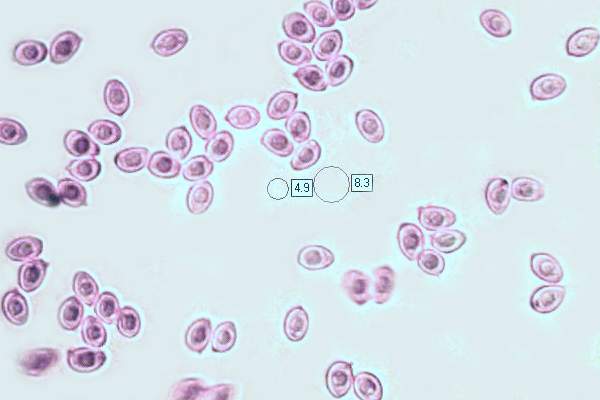Leucoagaricus leucothites (Vittad.) Wasser - White Dapperling
Phylum: Basidiomycota - Class: Agaricomycetes - Order: Agaricales - Family: Agaricaceae
Distribution - Taxonomic History - Etymology - Identification - Culinary Notes - Reference Sources
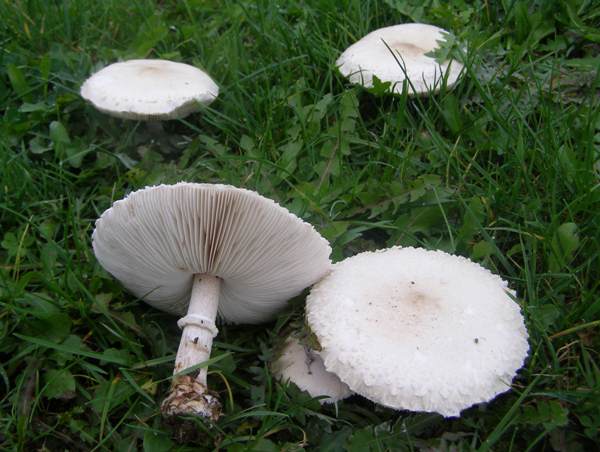
Looking something like a cross between a Parasol, Macrolepiota procera, and a Field Mushroom, Agaricus campestris, the White Dapperling differs from them both in having very much paler gills at maturity. Another difference becomes apparent when you make a spore print: the spores of Leucoagaricus leucothites are white in mass, whereas the Parasol has spores that are creamy white when seen in mass, and the Field Mushroom produces a deep chocolate brown spore print.
Distribution
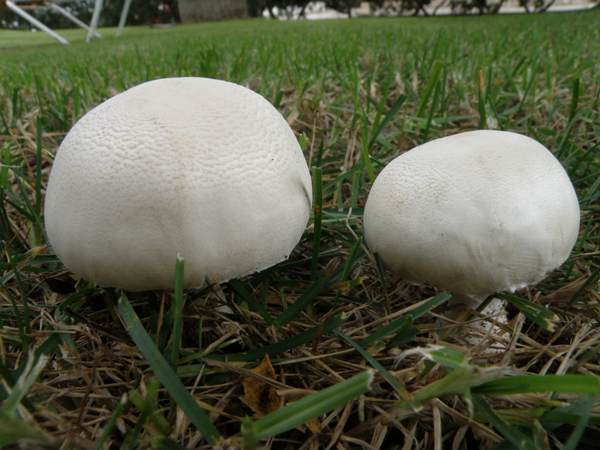
Although fairly common in Britain and Ireland, and found also throughout most of mainland Europe, these larger-than-life dapperlings tend to be localised. In fields where they occur there are often large numbers of them scattered around in groups. This species occurs in many other parts of the world including North America.
Taxonomic history
This chunky grassland mushroom was described in 1835 by the Italian medic and naturalist Carlo Vittadini (1800 - 1865), who gave it the scientific name Agaricus leucothites. (Most gilled fungi were placed in the Agaricus genus in the early days of fungal taxonomy, but the majority have since been relocated to new genera.) In 1977 the Ukrainian mycologist Solomon P Wasser (born 1946) transferred this species to the genus Leucoagaricus, establishing its currently accepted scientific name Leucoagaricus leucothites.
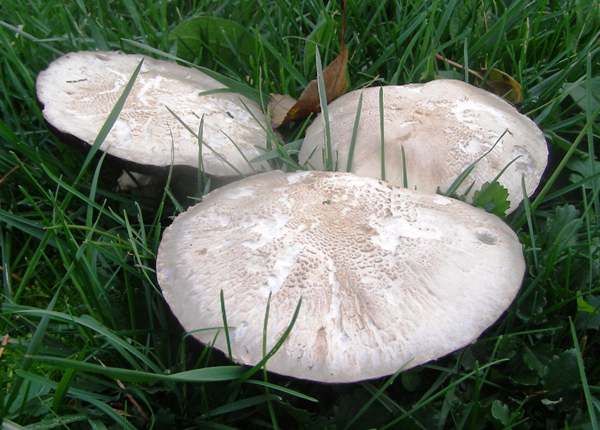
Synonyms of Leucoagaricus leucothites include Agaricus leucothites Vittad., Agaricus holosericeus Fr., Agaricus naucinus Fr., Lepiota naucina (Fr.) P. Kumm., Lepiota holosericea (Fr.) Gillet, Annularia laevis (Krombh.) Gillet, Lepiota naucina var. leucothites (Vittad.) Sacc., Leucocoprinus holosericeus (Fr.) Locq., Leucoagaricus naucinus (Fr.) Singer, Lepiota leucothites (Vittad.) P. D. Orton, and Leucoagaricus holosericeus (Fr.) M.M. Moser.
Etymology
Leucoagaricus is derived from the Greek Leucos meaning white and Agaricus, the genus name of the 'true mushrooms' as many people call the Field Mushroom, Horse Mushroom and their close relatives all of which have pink gills that darken when the brown or purple-brown spores mature. So Leucoagaricus suggests a group of white mushrooms that are in most respects similar to Agaricus species.
The specific epithet leucothites comes from the same Greek root leucos meaning white, but -thites had me foxed until Aren & Maria van Waarde kindly contributed the following suggestion, based on a dictionary of - Classical Greek written by Prof.G.J.M.Bartelink in 1958:
Thites comes from a Greek word spelled theta-eta-tau-epsilon-sigma, this was the name for the lowest - Class in society. The word thitikos (spelled theta-eta-tau-iota-kappa-omikron-sigma) means 'of the - Class of the thites', or in other words 'from the lowest - Class'. Thus leucothites might be read as 'the low - Class white' suggesting that the White Dapperling is edible but much less tasty than white agarics such as Agaricus campestris or Agaricus arvensis.
Identification guide
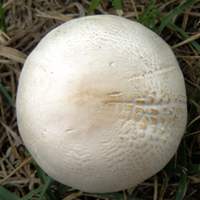 |
CapInitially convex, expanding to become almost flat; often smooth and silky but occasionally with tiny flakes or scales; white, gradually becoming flushed pale cream-ochre or flesh-coloured; smooth and silky. Cap diameter at maturity ranges from 3 to 9cm. |
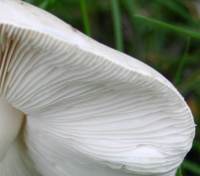 |
GillsThe free, crowded gills are pure white at first, eventually becoming pale flesh-pink. |
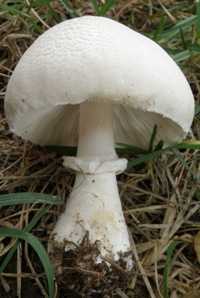 |
StemWhite; smooth above ring, longitudinally fibrillose below; cylindrical with a bulbous base; the white ring sometimes becomes moveable. 6 to 8cm long and 0.8 to 1.8cm in diameter. |
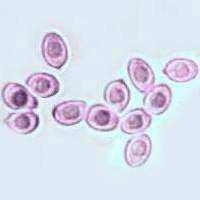 |
SporesOvoid, smooth, 7-9 x 4.5-5µm; dextrinoid. Spore printWhite. |
Odour/taste |
Not significant. |
Habitat & Ecological role |
Saprobic, usually in small groups in permanent pastures. |
Season |
June to October in Britain and Ireland; often several weeks later in southern Europe. |
Similar species |
Agaricus campestris has pink gills that turn brown as the spores mature. |
Culinary notes
Although these mushrooms are generally considered edible, some authorities say that White Dapperlings are slightly poisonous. There is also a risk of confusion with one of the toxic white toadstools that can occur in the same kinds of habitat. (The deadly Amanita species Deathcap and Destroying Angel have white gills.) My recommendation, therefore, is to follow the general guideline of shunning all white-gilled fungi.
Reference Sources
Fascinated by Fungi, 2nd Edition, Pat O'Reilly 2016, reprinted by Coch-y-bonddu Books in 2022.
Breitenbach, J & Kränzlin, F (1995). Fungi of Switzerland. Volume 4: Agarics (Part 2). Entolomataceae, Pluteaceae, Amanitaceae, Agaricaceae, Coprinaceae, Strophariaceae. Verlag Mykologia: Luzern, Switzerland. 368 p.
Noordeloos, M E, Kuyper, T W & Vellinga, E C (2001). Flora Agaricina Neerlandica—Critical monographs on the families of agarics and boleti occurring in the Netherlands. Volume 5. Agaricaceae. A. A. Balkema: Lisse, Netherlands. 169 p.
Dictionary of the Fungi; Paul M. Kirk, Paul F. Cannon, David W. Minter and J. A. Stalpers; CABI, 2008
Taxonomic history and synonym information on these pages is drawn from many sources but in particular from the British Mycological Society's GB Checklist of Fungi.
Fascinated by Fungi. Back by popular demand, Pat O'Reilly's best-selling 450-page hardback book is available now. The latest second edition was republished with a sparkling new cover design in September 2022 by Coch-y-Bonddu Books. Full details and copies are available from the publisher's online bookshop...
